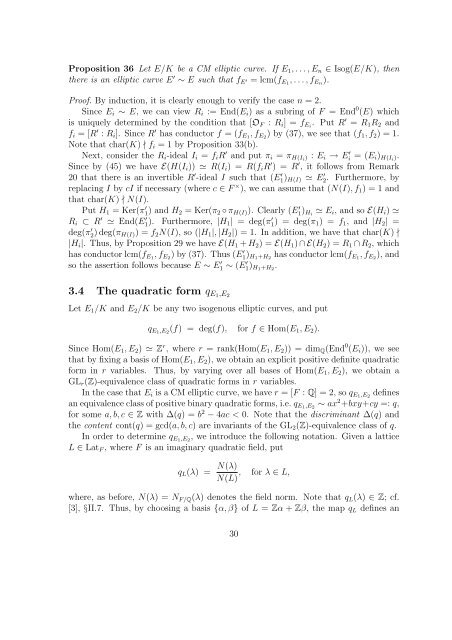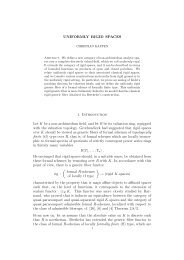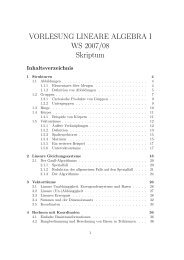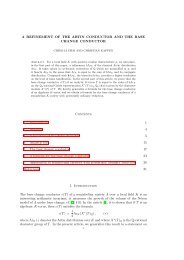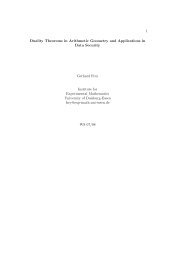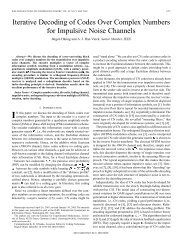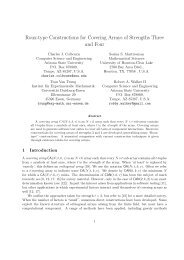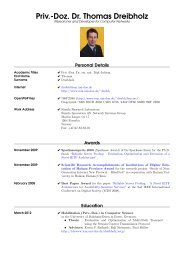Products of CM elliptic curves - Universität Duisburg-Essen
Products of CM elliptic curves - Universität Duisburg-Essen
Products of CM elliptic curves - Universität Duisburg-Essen
Create successful ePaper yourself
Turn your PDF publications into a flip-book with our unique Google optimized e-Paper software.
Proposition 36 Let E/K be a <strong>CM</strong> <strong>elliptic</strong> curve. If E 1 , . . . , E n ∈ Isog(E/K), thenthere is an <strong>elliptic</strong> curve E ′ ∼ E such that f E ′ = lcm(f E1 , . . . , f En ).Pro<strong>of</strong>. By induction, it is clearly enough to verify the case n = 2.Since E i ∼ E, we can view R i := End(E i ) as a subring <strong>of</strong> F = End 0 (E) whichis uniquely determined by the condition that [O F : R i ] = f Ei . Put R ′ = R 1 R 2 andf i = [R ′ : R i ]. Since R ′ has conductor f = (f E1 , f E2 ) by (37), we see that (f 1 , f 2 ) = 1.Note that char(K) ∤ f i = 1 by Proposition 33(b).Next, consider the R i -ideal I i = f i R ′ and put π i = π H(Ii ) : E i → E i ′ = (E i ) H(Ii ).Since by (45) we have E(H(I i )) ≃ R(I i ) = R(f i R ′ ) = R ′ , it follows from Remark20 that there is an invertible R ′ -ideal I such that (E 1) ′ H(I) ≃ E 2. ′ Furthermore, byreplacing I by cI if necessary (where c ∈ F × ), we can assume that (N(I), f 1 ) = 1 andthat char(K) ∤ N(I).Put H 1 = Ker(π 1) ′ and H 2 = Ker(π 2 ◦ π H(I) ). Clearly (E 1) ′ Hi ≃ E i , and so E(H i ) ≃R i ⊂ R ′ ≃ End(E 1). ′ Furthermore, |H 1 | = deg(π 1) ′ = deg(π 1 ) = f 1 , and |H 2 | =deg(π 2) ′ deg(π H(I) ) = f 2 N(I), so (|H 1 |, |H 2 |) = 1. In addition, we have that char(K) ∤|H i |. Thus, by Proposition 29 we have E(H 1 + H 2 ) = E(H 1 ) ∩ E(H 2 ) = R 1 ∩ R 2 , whichhas conductor lcm(f E1 , f E2 ) by (37). Thus (E 1) ′ H1 +H 2has conductor lcm(f E1 , f E2 ), andso the assertion follows because E ∼ E 1 ′ ∼ (E 1) ′ H1 +H 2.3.4 The quadratic form q E1 ,E 2Let E 1 /K and E 2 /K be any two isogenous <strong>elliptic</strong> <strong>curves</strong>, and putq E1 ,E 2(f) = deg(f), for f ∈ Hom(E 1 , E 2 ).Since Hom(E 1 , E 2 ) ≃ Z r , where r = rank(Hom(E 1 , E 2 )) = dim Q (End 0 (E i )), we seethat by fixing a basis <strong>of</strong> Hom(E 1 , E 2 ), we obtain an explicit positive definite quadraticform in r variables. Thus, by varying over all bases <strong>of</strong> Hom(E 1 , E 2 ), we obtain aGL r (Z)-equivalence class <strong>of</strong> quadratic forms in r variables.In the case that E i is a <strong>CM</strong> <strong>elliptic</strong> curve, we have r = [F : Q] = 2, so q E1 ,E 2definesan equivalence class <strong>of</strong> positive binary quadratic forms, i.e. q E1 ,E 2∼ ax 2 +bxy+cy =: q,for some a, b, c ∈ Z with ∆(q) = b 2 − 4ac < 0. Note that the discriminant ∆(q) andthe content cont(q) = gcd(a, b, c) are invariants <strong>of</strong> the GL 2 (Z)-equivalence class <strong>of</strong> q.In order to determine q E1 ,E 2, we introduce the following notation. Given a latticeL ∈ Lat F , where F is an imaginary quadratic field, putq L (λ) = N(λ) , for λ ∈ L,N(L)where, as before, N(λ) = N F/Q (λ) denotes the field norm. Note that q L (λ) ∈ Z; cf.[3], §II.7. Thus, by choosing a basis {α, β} <strong>of</strong> L = Zα + Zβ, the map q L defines an30


